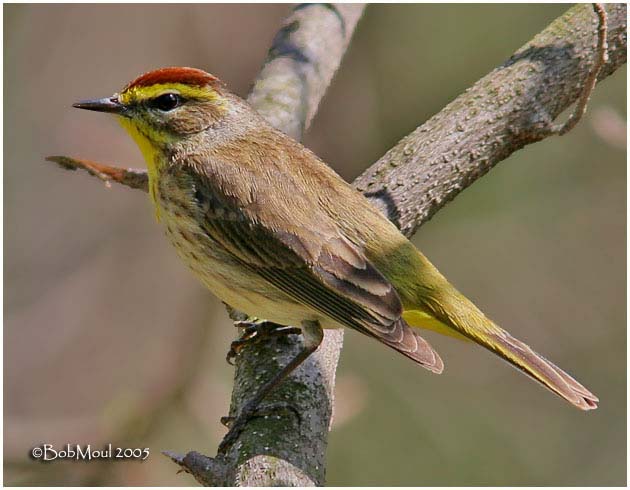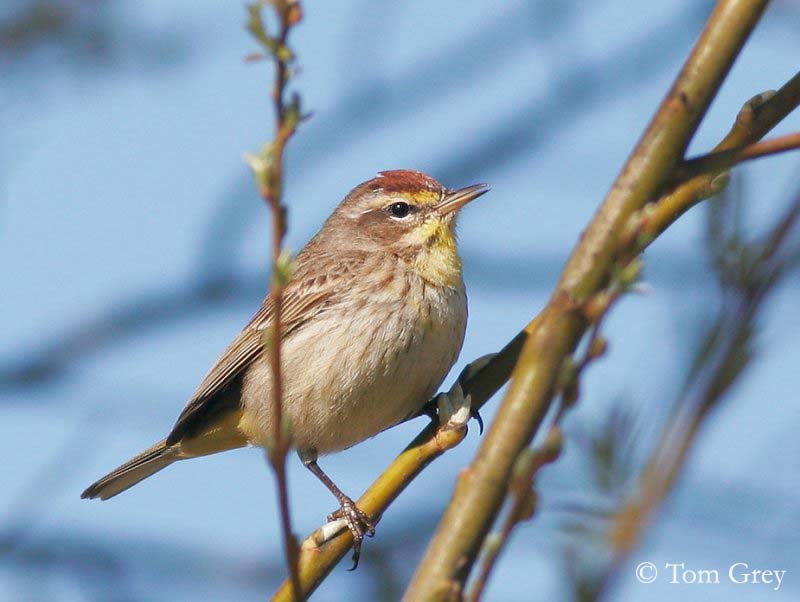
Palm Warbler
Setophaga palmarum
Passeriforme Order – Parulidae Family
BIOMETRICS:
Length : 12-14 cm
Wingspan : 20-21 cm
Weight : 7-13 g
LONGEVITY: up to 6 years
DESCRIPTION:
Palm Warbler occurs in two forms.

Western Palm Warbler (Dendroica palmatrum palmarum) breeds in the West part of the range. It is duller, and has whitish belly.
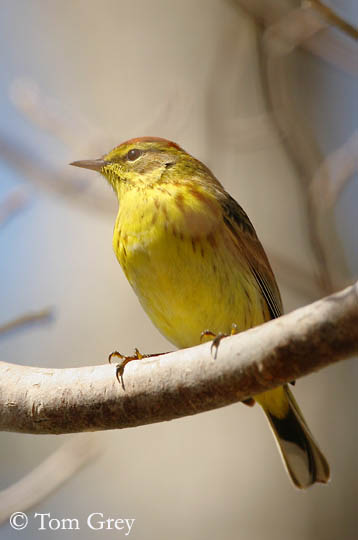
Yellow Palm Warbler (Dendroica palmarum hypochrysea) breeds in the East part. It is entirely yellow underneath.
Palm Warbler is a relatively large, dull greyish-olive warbler in most plumages, with diffuse streaking on mantle and flanks of varying intensity. Underparts are whitish from lower breast down, with buff wash on throat and breast. It has a long pale supercilium, and bright yellow undertail coverts. Dull overall coloration contrasts with mainly blackish wings, and double white wing bars.
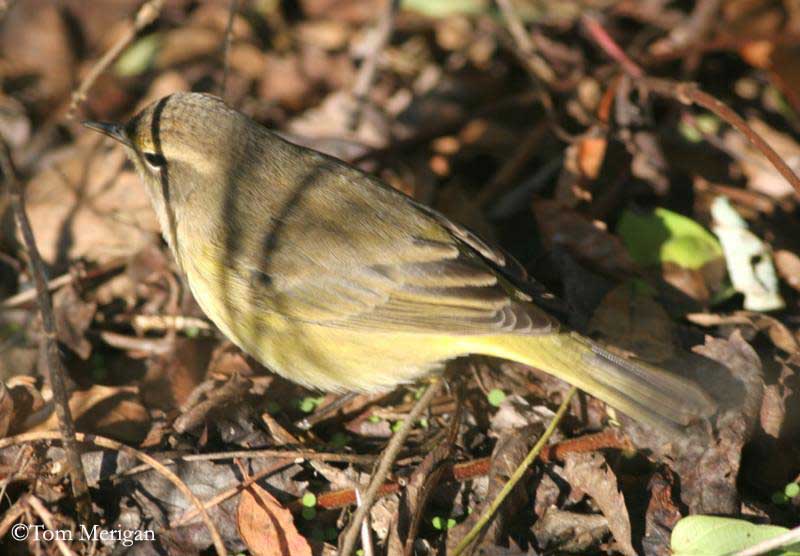
Adult male summer is heavily streaked black and white, with black crown and white throat and ear coverts. In alternate plumage, it presents a rufous crown.
Adult female has dark-streaked, greyish-green crown and ear coverts, greyish green tinge to mantle, whitish supercilium and dark eye-stripe (absent in male), and a very faint yellow tinge on underparts.
Legs are usually pinkish or yellowish, but in some, they are darker and browner. Bill is black and pointed, paler at base of lower mandible. Eyes are small and black.
Both sexes are similar.
Immature is similar to adults.
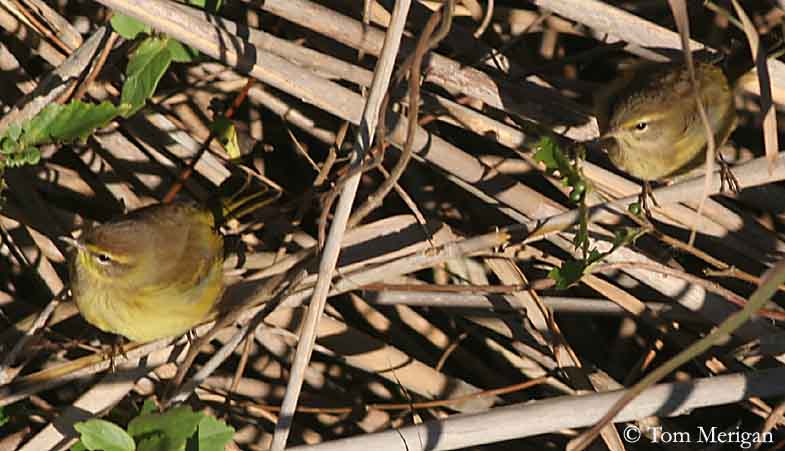
VOICE: SOUNDS BY XENO-CANTO
Palm Warbler’s call includes a loud “smack”, a loud and hard “chip”, and a thin and high “seet”. Song is an extremely high “sit-sit-sit-sit-sit-…” increasing in volume before fading.
HABITAT:
Palm Warbler breeds in northern coniferous forests, especially spruces, and including burnt areas, forest edges and stunted forest at the edge of the tundra, but usually near water. At other times, it is found in a broad range of woodlands, thickets, bushy areas, on the ground in savannah and open fields, and in mangroves.
RANGE:
Palm Warbler breeds across Canada, from northern territories to Newfoundland, southward to Minnesota, Wisconsin, Michigan, New York and Maine.
It winters along Pacific coasts of United States, and south eastern United States, the Yucatan, Central America and the Caribbean.
BEHAVIOUR:
Palm Warbler is very active, constantly on the move between trees and bushes, hovering and flycatching. Usually, it wags its tail as it forages. It also feeds on the ground, and in short shrubs and trees. It forages in open grassy areas in winter. It is a diurnal visual forager.
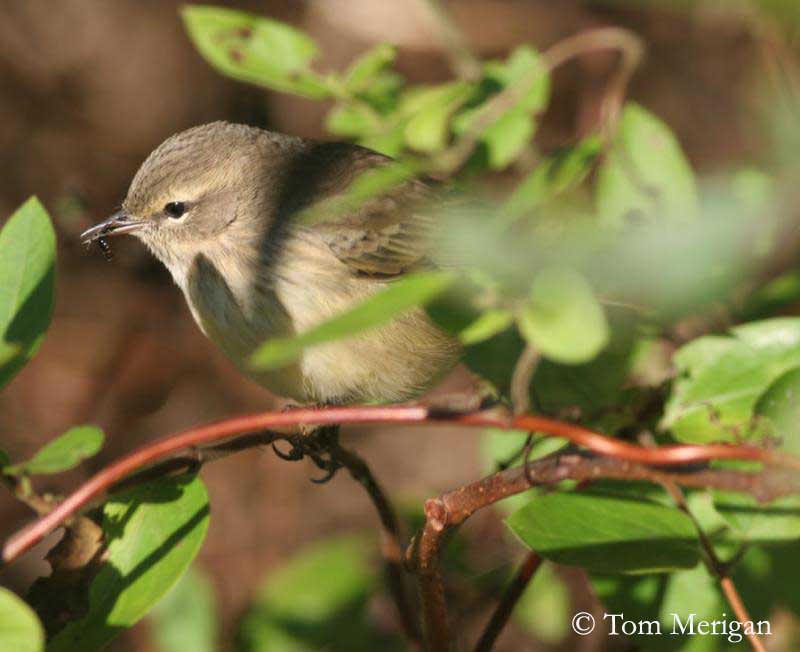
Palm warbler is the principal victim of cowbird parasitism. It responds by burying a new nest underneath, with some of its own eggs. Nests with up to 6 layers have been found, females stealing nesting material from each other.
Palm warbler sometimes joins mixed flocks of warblers and other species, during fall and winter.
Palm warbler chases and fight intruding males during breeding season, and on wintering grounds. In a breeding territory, intruders announce their presence by singing, but territory owner chases away the intruder and sing from a post to proclaim ownership.
FLIGHT:
Palm Warbler has a very strong and bounding flight.
REPRODUCTION:
Palm Warbler’s nest is an open cup of weed stalks, grass, sedges, bark shreds, rootlets, and ferns, and lined with fine grasses, and sometimes hair and feathers. It is located in sphagnum moss (Sphagnum cymbifolium), at base of short tree.
Female lays 4 to 5 creamy white eggs, speckled with dark. Incubation lasts about 12 days, by female, fed by the male. Young hatches helpless. They fledge at about 12 days, and can fly short distances within a few days of fledging. Both parents feed the young at nest.
This species generally produces one brood per year, sometimes two.

DIET:
Palm Warbler feeds primarily on insects, grasshoppers, beetles, flies, bugs, butterflies and moths, wasps, bees and ant larvae.
During fall and winter, it feeds on seeds, insects and berries, in addition to nectar from plants.
PROTECTION / THREATS / STATUS:
Palm Warbler is the principal victim of cowbird parasitism, but it responds very well. It is also one of the most common victims to illuminate towers and buildings. Grey jays, short-tailed weasels and garter snakes have been reported as possible nest predators.
Fr: Paruline à couronne rousse
All : Sumpfwaldsänger
Esp : Chipe Palmero
Ital: Dendroica delle palme
Nd: Palmzanger
Sd: Brunhättad skogssångare
Photographs by Tom Merigan
His website:
Tom Meriganís Photo Galleries
Photographs by Tom Grey
His website :
Tom Grey's Bird Pictures
Photograph by Bob Moul
His website:
Nature Photography
Text by Nicole Bouglouan
Sources:
FIELD GUIDE TO THE BIRDS OF NORTH AMERICA by National Geographic Society - National Geographic Society - ISBN: 0792274512
All About Birds (Cornell Lab of Ornithology)
What Bird-The ultimate Bird Guide (Mitchell Waite)
Wikipedia (Wikipedia, The Free Encyclopedia)
Bird Web (Seattle Audubon Society)
The Birds of North America online
Animal Diversity Web (University of Michigan Museum of Zoology)
